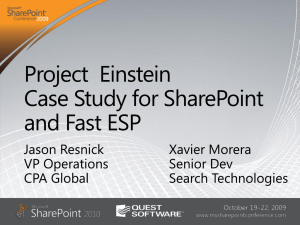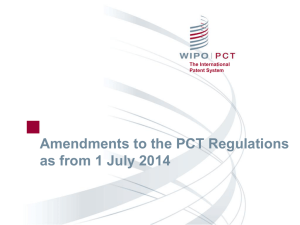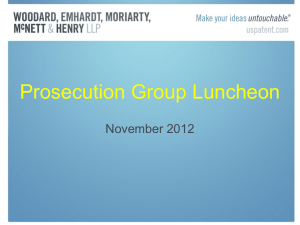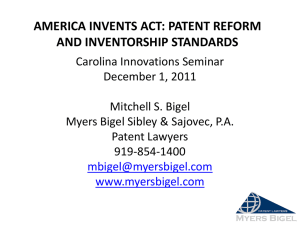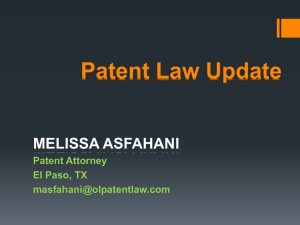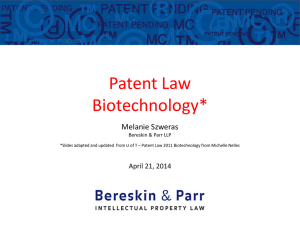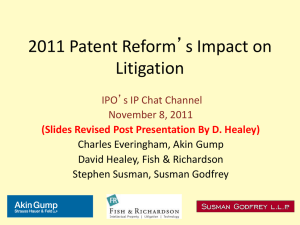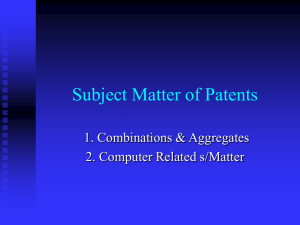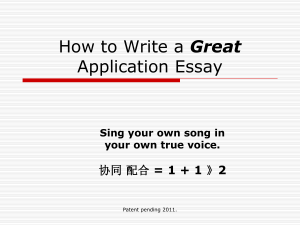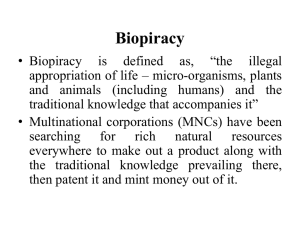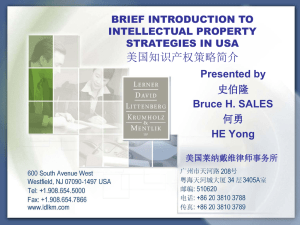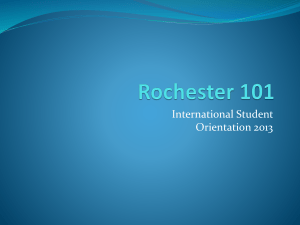Introducing UR Ventures – the Future of Technology Part I
advertisement
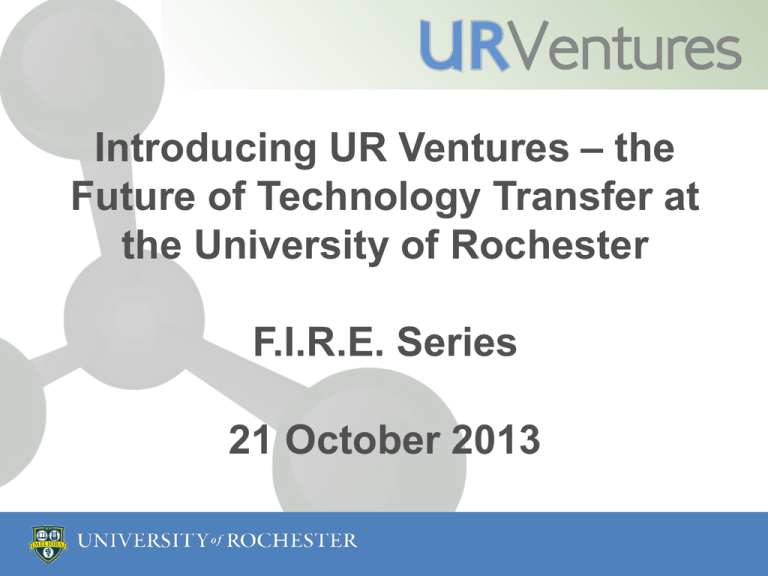
Introducing UR Ventures – the Future of Technology Transfer at the University of Rochester F.I.R.E. Series 21 October 2013 Rob Clark Senior Vice President for Research & Dean, Hajim School of Engineering The Origins of New Medicines & The Importance of Academic Research & Discovery •Steve Dewhurst The Problem: Annual NME Output is Stagnant 1-time FDA clearance of an application backlog Munos B. Lessons from 60 years of pharmaceutical innovation. Nature Reviews Drug Discovery 8, 959-968, 2009 While NME Cost is Accelerating Munos B. Lessons from 60 years of pharmaceutical innovation. Nature Reviews Drug Discovery 8, 959-968, 2009 Result: An Exponential Decline in R&D Efficiency Scannell JW, Blanckley A, Boldon H & Warrington B . Nature Reviews Drug Discovery 11, 191-200, 2012 NME Development: The Numbers • • • • • • • Output • Annual output has not changed in 60 years! (20-30 approvals/yr) Success rate • Only 11.5% of drugs that enter clinical trial reach NME status. Cost Estimated ~$5Bn per NME (2013). Erooms Law: # of new drugs approved per $1bn spent on R&D has halved roughly every 9 years since 1950 • This is Moore’s law, backwards (contrasting it to technologies that improve exponentially over time) Munos B. Lessons from 60 years of pharmaceutical innovation. Nature Reviews Drug Discovery 8, 959-968, 2009 Scannell JW, Blanckley A, Boldon H & Warrington B . Nature Reviews Drug Discovery 11, 191-200, 2012 Herper, M. Forbes, 2013. http://www.forbes.com/sites/matthewherper/2013/08/11/how-the-staggering-cost-of-inventing-new-drugs-is-shaping-the-future-of-medicine/ The Current Model is Not Sustainable •Cost of New Drug Discovery is Too High: •• Globally, companies spend $135bn on R&D each year, to yield 25-30 new drugs – many of which are marginally effective and sold at huge prices •And Pharma is Facing a Patent Cliff: •• Over $290bn of sales at risk from patent expiration in 2012-2018 •• Results from a wave of successful products discovered in the late 1980s reaching the end of their patented life Munos, B. Sci. Transl. Med. 5, 168ed1 (2013); Munos, B. & Chin, W.W. Sci. Transl. Med. 3, 89cm16 (2011) …And Pharma is Struggling to Respond • Responses include: • Acquisitions & mergers • Increased R&D spending: > $1.1 trillion over the last 10 years • Issue: “too much money chasing too few quality R&D assets” EvaluatePharma, Embracing the Patent Cliff (2012); www.evaluatepharma.com/worldpreview2018.aspx. Munos, B. Sci. Transl. Med. 5, 168ed1 (2013); http://www.bioworld.com/content/pharma-summits-patent-cliff-2012-290b-sales-risk-through-2018 How Did We Get Here? •Pharma Stopped Doing Risk-Taking, Breakthru Science: •• Pharma “walked away from the translational research model that made it great: risk-taking and breakthrough science” •A risk-averse course of “marginal innovation” failed - in part because marginal compounds are themselves risky Munos, B. Sci. Transl. Med. 5, 168ed1 (2013); Munos, B. & Chin, W.W. Sci. Transl. Med. 3, 89cm16 (2011) We Need New Models: Role of NIH • • Bolder innovation. Key role of NIH-funded research and academic partners. • • Faster innovation. Drug repurposing is one approach (NCATS). • • Speedier R&D. Developing shared tools and common standards (NIH), including better evidence-based medicine and use of EMR (PCORI). • • More collaboration. Avoid repeating the same mistakes. Munos, B. Sci. Transl. Med. 5, 168ed1 (2013) Academia is a Major Driver of New Drugs Distribution of the discovery of the 252 new drugs approved by the US FDA (1998-2007), classified by whether are scientifically novel (new) or follow-on (old). Kneller, R. The importance of new companies for drug discovery: origins of a decade of new drugs. Nat. Rev. Drug Disc. 9, 867-882, 2010. Universities & Biotechs Drive Innovation • • ~50% of scientifically innovative new drugs came from Univs & Biotechs • • ~50% of drugs responding to unmet medical needs also came from this source • • Most of the Biotechs were located in the U.S. Kneller, R. The importance of new companies for drug discovery: origins of a decade of new drugs. Nat. Rev. Drug Disc. 9, 867-882, 2010. And Innovation is Led by U.S. Institutions • Reasons include: • • Government funding: U.S. spends a ~2x higher fraction of GDP on academic biomedical research • • Peer review: U.S. uses a rigorous peer review system to award research funds (less so in Japan) • • Career flexibility: More accepted to move between academia and biotechs in the U.S. • • Pro-entrepreneurial climate: Immigration policies; financing; Bayh-Dole Act encourages licensing of university discoveries Kneller, R. The importance of new companies for drug discovery: origins of a decade of new drugs. Nat. Rev. Drug Disc. 9, 867-882, 2010. Academia Leads in Rare & Orphan Diseases •Orphan Drug Market is Expanding: •• Expected to account for $127bn in sales in 2018 (or 16% of the global prescription drug market, excluding generics) •Reasons: •Smaller disease populations require smaller (cheaper) trials •Well-defined subpopulations more likely to respond to an investigational drug •Improved patient outcomes raise economic value of new drugs EvaluatePharma, World Preview 2013, Outlook to 2018 (2013); www.evaluatepharma.com/worldpreview2018.aspx. Conclusions •Universities have a key role in the innovation economy and the development of new drugs, diagnostics & devices. This includes: • Serving as the Engine of New Discovery: Resulting in half of new drugs and biologics • Addressing Unmet Needs and Orphan Diseases: Accounting for half of new drugs for previously unmet needs • Seeding New Businesses: University biotechs create jobs and conduct early phase product development • De-risking New Targets and Approaches: Public-private partnerships will be increasingly key to lowering costs What Does This Mean for UR? •Fund Early-Phase Development of New Ideas & Technologies •Drug Development Pilot Award (DDPA): $4-8k, $25k • http://ddpa.urmc.edu •Technology Development Fund (TDF): $40-100k (needs to be expanded) – https://www.rochester.edu/TechnologyDevelopment/ •Provide Access to Expert Management Expertise •URVentures Project Management: Develop technologies more fully “in house”; leverage internal resources to do so Drug Development Pilot Awards (DDPA) •Status • Started mid 2012; addresses a Key Gap: access to HTS & medicinal chemistry • # of Supported Projects: 10 (Early Exploratory); 3 (Lead Finding) • Funds Awarded: $148K to date, out of $250K committed • Outcomes: Manuscripts: 1 pub, 6 sub; Grants: R01 (Dunman), American Lung RG (Rahman); pending R21 (Pang) • ROI to date: $1.2 million in total costs (new grants); ~8:1 Technology Development Fund (TDF) •Status • Supports technology development (which NIH will not fund) • # of Supported Projects: 11 (since 2009) • Funds Awarded: $766K to date, out of ~$1M raised • Increasing Interest: 22 applications in current round • Outcomes: 8 moving forward; several have achieved either follow on funding or increased business interest; 3: have proved their concept does not work Internal Resources: CTSI, cGMP Facility •CTSI •Broad regulatory knowledge (e.g., FDA) •Center for Human Experimental Therapeutics (CHET): Supports first-in-human studies (IND prep., clinical trial design/support) •Access to partners with key resources (e.g., GMP chemistry) •Upstate cGMP Stem Cell Facility •Opened 2012; produces cells, proteins (Mabs) under GMP, for firstin-human studies •Supporting projects with a total of $26 million in funding – including major programs on macular degeneration, M.S. Summary •UR life science technologies have enormous potential for societal good & commercial impact. Realizing this potential depends on: •Early Phase Funding: To develop new technologies. We need to increase support for TDF and explore new models. •The Internal UR Ecosystem: We have access to many of the assets necessary to develop life science technologies. •Our External Ecosystem: We need business & project management expertise, and early-stage investors. May also be value to a “WNY Biotech Consortium”, like the New York Academic Consortium formed by the 7 NYC biomedical schools. Brand Launch and New Approach • Scott Catlin • AVP, Technology Ventures • October 21, 2013 Mission • To develop UR innovations into valuable products and services to make the world ever better. Mission • To develop UR innovations into valuable products and services to make the world ever better. New Name and Brand • Building a new image and approach • Project Management – treat technologies as if we are personally building a business around them; “hand-craft” plan to fit technology • Customer focused • Proactive engagement with the ecosystem New Website Fundamental Challenge Commercial Interest University Research • • • We generally get stuck here Ground breaking research Driven by research, grants, publications Limited business input and often no business partner • • Risks and interest depend on: • Proof of concept • Regulatory hurdles • Technology and market opportunity • Corporations vs. Start-ups and Investor types • Researcher engagement and team development Limited proof-of-concept investment Commercial Products/Services • • • • Development of solutions valued by the market Customer and market driven Sustainable growth Seek risk mitigation and barriers to entry via IP, regulatory, cost advantages Solution and Focus Commercial Interest University Research • Prove the concept, e.g. • Prototyping, customer feedback, market • Earlier clinical-regulatory input • Researcher engagement and team development Commercial Products/Services Ecosystem Development Community Faculty Studen ts Alumni Expectations • Overall: more business-based in our decisions and plans • On URVentures: • • • • Project management Roadmap – building a transparent plan for the team Creativity, flexibility, customer service Community engagement • On Faculty: • Participation and business partnership • Flexibility and creativity • On Community: engagement, interest and support Final Thoughts • We’re open for business – seeking to make the world ever better with our technologies and discoveries • “Life shrinks or expands in proportion to one’s courage.” – Anais Nin • Fortes fortuna adjuvat Inventions and Patenting Carissa R. Childs, Ph.D. Merkel 70 Linden Oaks, Suite 210 Oaks, Suite 210 Rochester, New York 14625 New York 14625 Edwin V. 70 Linden Rochester, Inventions and Patenting The U.S. Patent System Patentable Subject Matter Requirements for Patentability The U.S. Patent System Foundation of U.S. Patent System – An Exchange Between U.S. Gov’t and Inventors: Issued patent affords “right to exclude” others The term for patents issuing on applications filed prior to June 8, 1995 is the longer of 17 years from issue or 20 years from filing The term for patents issuing on applications filed on or after June 8, 1995 is 20 years from filing In exchange, the public receives a written disclosure of the invention so that it can practice the invention when the patent expires Patentable Subject Matter Patentable Subject Matter A Process or Method • e.g. Method of treating cancer, or method of preventing bacterial infection Patentable Subject Matter (cont'd) Patentable Subject Matter (cont'd) A Process or Method • e.g. Method of treating cancer, or method of preventing bacterial infection A Machine or Device • e.g. Printing press An Article of Manufacture • e.g. Antibody, genetically altered cell line, wound dressing Patentable Subject Matter (cont'd) Patentable Subject Matter (cont'd) A Process or Method • e.g. Method of treating cancer, or method of preventing bacterial infection A Machine or Device • e.g. Printing press An Article of Manufacture • e.g. Antibody, genetically altered cell line, wound dressing • Composition of Matter • e.g. Pharmaceutical compound (active agent) or formulation, vaccine, fertilizer formulation Requirements of Patentability Requirements for Patentability 1. 2. 3. 4. Patentable subject matter Utility Novelty Nonobviousness Novelty and Nonobviousness Based on “prior art” America Invents Act (AIA) changed the definition of prior art • Effective March 16, 2013 • But not applicable to all applications –Some applications will be examined using the current definition (will continue for ~21 years) –Some applications will be examined using the new definition Prior Art – AIA Information publicly available as of the application filing date • Journal articles, abstracts, poster sessions, a thesis, etc., are prior art once they become publicly available • Offers for sale, including presentations to potential licensees, are prior art under certain circumstances Under old law – public availability was viewed with respect to date of invention, not filing date. Prior Art – AIA (cont’d) Grace period for inventor related publication: • Publications by inventors available less than one year before application filing date are not prior art. –Includes publications by others who obtained the subject matter from the inventor(s) (e.g., stolen work) or –Subject matter that was publicly disclosed by the inventor first • Available in U.S. and a few other countries in limited circumstances • University of Rochester • Policy on Intellectual Property and Technology Transfer Gail Norris Policy Objective • The IP Policy is intended to: • • • • Protect the intellectual property arising out of • University research Provide rules on the ownership interest of the University in intellectual property Provide general terms for the licensing of technology owned by the University for the sharing of any revenues from the licensing Who’s Covered • • All faculty, employees, students, fellows, and visiting scientists conducting research using our facilities. What’s Covered • Copyrights • Patents • Tangible Research Property • that is developed with significant use of University resources or as part of your job responsibilities is owned by the University and covered by this Policy Significant Use of University Resources • Examples: grant funding, laboratory equipment, students, sophisticated software programs available at the University • What’s not significant use of University resources: common office equipment such as computers, telephones, consumer software programs. Copyrights • Law provides that work done as part of your job is “work for hire” and owned by your employee • In keeping with academic tradition, the University generally does not claim copyright ownership in articles, textbooks, theses, poems, musical compositions and similar works which are intended to disseminate results of academic research, scholarship, artistic expression, etc. • Exceptions: significant use of university research and institutional works. MOOC Controversy • Setting the stage • On –line learning “continuum of issues” • AAUP report on Faculty Rights • “New AAUP report describing attempt by university administrators to claim ownership of faculty IP; educational campaign to inform faculty about their rights” Licensing • Licensing Process • Invention Disclosure • Patenting Determination • Importance of Inventor/Author assistance • Marketing • Royalties • 1st $50,000 • $50k - $250K • Above $250K 50% 40% 35% Questions • The Importance of Material Transfer and Confidential Disclosure Agreements in Shared Research Presented by: Donna L. Beyea Associate Director Office of Research & Project Administration donna.beyea@rochester.edu Phone: 275-8037 What is a Material Transfer Agreement (MTA)? o An MTA is the contractual instrument used to define the terms and conditions for the exchange of research materials. o The MTA typically sets forth rights to use the materials and allocates the rights that result from their use. Reason for an MTA: o The material and/or information is proprietary or confidential. o The provider wants to restrict how the material is to be used. o The material is infectious, hazardous or subject to special regulations. o The provider wishes to protect against any potential liability. o The provider wishes to obtain rights to the results of the research for which the material or information is to be used. o The provider wishes to ensure that correct and appropriate acknowledgement is included in any publication regarding the use of the material. Different Types of MTAs: o Electronic Material Transfer Agreement o Simple Letter Agreement (SLA) o Uniform Biological Material Transfer Agreement (UBMTA) o Institutional based MTA (drafted by the providing institution) Areas of Concern o DEFINITION OF MATERIAL o DATA PROTECTION o PUBLICATION o INTELLECTUAL PROPERTY o INDEMNIFICATION o CONFIDENTIAL INFORMATION Signature of Authorized Representatives: o Signature of an Authorized Institutional Official is required. Faculty members are not authorized to legally bind the University in any type of contract. o MTAs are normally signed by ORPA. o PI can sign as “Read & Acknowledged” What is a Confidential Disclosure Agreement (CDA)? o A Confidential Disclosure Agreement (or a Nondisclosure Agreement) is an agreement under which one or both parties agree to maintain confidentiality regarding proprietary information (“Confidential Information”) that one party receives from the other party (“Information Owner”). Types of CDAs: o One-way CDA: Only the Receiving Party is bound by obligations of confidentiality. o Two-way (Mutual): Both Parties are bound by obligations of confidentiality to confidential information received from the other Party. Areas of Concern in a CDA: o TERM OF AGREEMENT vs TERM OF CONFIDENTIALITY o INTELLECTUAL PROPERTY o SIGNATORIES If a PI Leaves UR: o When a principal investigator leaves UR it is highly recommended that they contact our office early so we can work with them to assure a timely resolution to any ongoing obligations pertaining to active MTAs/CDAs. o Things to consider – Do you plan to: 1) continue using materials you received from another institution at your new place of employment; 2) transfer material made while at the University of Rochester to you new place of employment; 3) transfer materials and research to another PI within UR; or 4) discontinue use of materials covered under an existing Questions? Material Transfer Administrators: Gila Balman: gila.balman@rochester.edu ext: 3-4512 Jena Ashley: jena.ashley@rochester.edu ext: 5-5115 Inventions and Patenting Carissa R. Childs, Ph.D. Merkel 70 Linden Oaks, Suite 210 Oaks, Suite 210 Rochester, New York 14625 New York 14625 Edwin V. 70 Linden Rochester, Inventions and Patenting The Process for Obtaining a Patent Inventorship The U.S. Patent Process What You Need to Do to Get a Patent? Step 1: Invent Something that is Patentable Must be patentable subject matter Must be new and non-obvious Must be useful Step 2: Submit Invention Disclosure Submit an invention disclosure to UR Ventures prior to any public disclosure • e.g. Scientific meeting, manuscript publication, presentation to potential collaborators, etc. Disclose early and update often Identify competitors and relevant prior art If possible, identify commercial applications and potential entities that would be interested Step 3: Prepare & File Patent Application U.S. patents are obtained by filing a written application which includes the following components: • Specification –Background of the invention –Summary of the invention –Detailed description of invention • Claims • Drawings Inventor participation in patent drafting process is critical Step 4: The Patent Process Filing – the application is submitted to the U.S. Patent and Trademark Office (“PTO”), along with a fee and an oath executed by the inventor stating certain required facts Wait – Up to several years! The Patent Process (cont’d) Examination: • The application is reviewed by a patent examiner • The examiner searches prior art patents and publications and decides either to allow claims or to reject them • Written rejections are mailed out to the applicant • Responses are filed by applicant –Inventor input on prior art cited by PTO is often critical • Repeat, as needed Step 5: Pay Issue & Maintenance Fees Issuance of a patent: • An allowed application issues as a patent once an issue fee is paid • Maintenance fees must be paid during the fourth, eighth, and twelfth years of the patent term –Cost increases for each maintenance fee Inventorship Inventorship General • U.S. patent applications are filed in the name of the inventor(s) or the owners. –PTO records assignments of patent rights from inventors to owners. Definition: “Determining ‘inventorship’ is nothing more than determining who conceived the subject matter ….” Inventorship is determined by what is claimed. • May change during prosecution of the application Inventorship (cont'd) • Consequences of incorrect inventorship - a patent cannot lawfully issue to those who are not inventors. • Inventorship dictates ownership –No contractual obligation the inventor is the owner. –Contractual obligation can change who is the owner. • Assignment obligation • Material transfer and technology development agreements THANK YOU Intermission: We will reconvene at 11:30 a.m.
